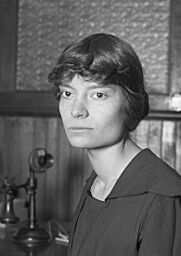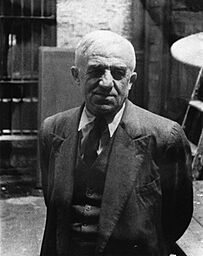Catholic Worker Movement facts for kids

Logo/masthead used on the Catholic Worker Movement website and newspaper
|
|
| Formation | May 1, 1933 |
|---|---|
| Founders |
|
| Purpose | Catholic Anarchist activism |
|
Membership (2023)
|
200 Catholic worker houses of hospitality and farms internationally |
| Publication | Catholic Worker newspaper |
The Catholic Worker Movement is a group of independent communities started in the United States in 1933. It was founded by two important people, Dorothy Day and Peter Maurin. Their main goal is to "live in a way that shows the fairness and kindness of Jesus Christ."
A key idea of the movement is to welcome and help people who are struggling. This is based on ideas of working together and respecting each person. Today, there are over 240 local Catholic Worker communities around the world. These groups offer help and support to people in need. Each "house" or community works in its own way. They try to bring about social justice in their local area.
Catholic Worker houses are not official parts of the Catholic Church. Their activities are inspired by Dorothy Day's example. Some groups are more religious, while others focus more on social action. The movement strongly supports nonviolence. They work against war and the unfair way wealth is shared globally. Dorothy Day also started the Catholic Worker newspaper. It is still published by two Catholic Worker houses in New York City. You can buy it for just one penny!
Contents
History of the Catholic Worker Movement
The Catholic Worker Movement began with a newspaper called the Catholic Worker. Dorothy Day created it to share Catholic social teachings. She wanted it to offer a peaceful, Christian view during the wars of the 1930s.
Dorothy Day wanted to do more than just write. She started "houses of hospitality" to put her ideas into action. These houses were places where people could find help and shelter. Later, she also started farms where people could live and work together. This idea of living simply and helping others was called "voluntary poverty". Many people who came for help later became volunteers themselves.
At first, these houses were very informal. Over time, some basic rules were made. Dorothy Day chose the leaders for each house. Each house worked on its own and grew differently. For example, in the 1930s, the St. Louis Workers helped 3,400 people daily. The Detroit Workers helped about 600 people each day.
The Catholic Worker newspaper helped spread the movement's ideas. People who worked in the houses wrote about their experiences. This led to new communities in the United States, Canada, and the United Kingdom. By 1941, more than 30 independent communities had started.
Between 1965 and 1980, 76 more communities were founded. About 35 of these are still active today. One example is the "Hippie Kitchen" in Skid Row, Los Angeles. It was started in the 1970s by two Catholic Workers. Today, there are over 200 Catholic Worker communities. They are found in places like Australia, Germany, Mexico, and New Zealand.
Dorothy Day passed away in 1980. The Catholic Church is currently considering her for sainthood.
What the Catholic Worker Movement Believes
Dorothy Day once said, "Our rule is the works of mercy." She meant that helping others is their main guide. She also spoke of sacrifice, worship, and respect.
Peter Maurin, the co-founder, explained the beliefs of the Catholic Worker. Here are some of their core ideas:
- They believe in the gentle way of traditional Catholicism. This means being kind and personal.
- They feel a personal duty to care for others in need.
- They practice the Works of Mercy every day. These are actions like feeding the hungry or sheltering the homeless.
- They create houses of hospitality. These places offer immediate help to those who need it.
- They set up Farming Communes. Here, everyone works based on what they can do. They also receive what they need.
- They aim to build a "new society within the shell of the old". This means creating a better way of living within the current world.
The group's ideas can be called Christian anarchism. This means they believe God is the highest authority. They think the government should not have total power over people. Anne Klejment, a history teacher, wrote about the movement. She said they followed Christ as a model for peaceful change. Christ respected what each person believed. He also shared a powerful message that was hard for many to accept.
How Families Get Involved
Families play different roles in the Catholic Worker Movement. Sometimes, people who donate money want it to go directly to helping the poor. Supporting a volunteer family can cost more than supporting one person. Dorothy Day's ideas about families in the movement were sometimes debated.
However, families still take part in many ways. Some families help out at the houses of hospitality. Others open a "Christ room" in their own homes for people who need a place to stay. Many families even run their own Catholic Worker houses.
See also
- Catholic Radical Alliance
- Catholic social teaching
- Christian anarchism
- Christian pacifism
- Christian radicalism
- Christian views on poverty and wealth
- Friendship House
- Industrial Workers of the World
- Liberation theology
- List of anti-war organizations
- Political Catholicism
Similar Christian movements
- Anabaptism, especially the peace church movement
- Beguines and Beghards, old religious groups of regular people
- Christian democracy, especially distributism
- Focolare, a Catholic movement for unity and brotherhood
- Madonna House Apostolate
- "New Monasticism" and similar communities
- Peace Churches
- Servants to Asia's Urban Poor
- Labour Church



